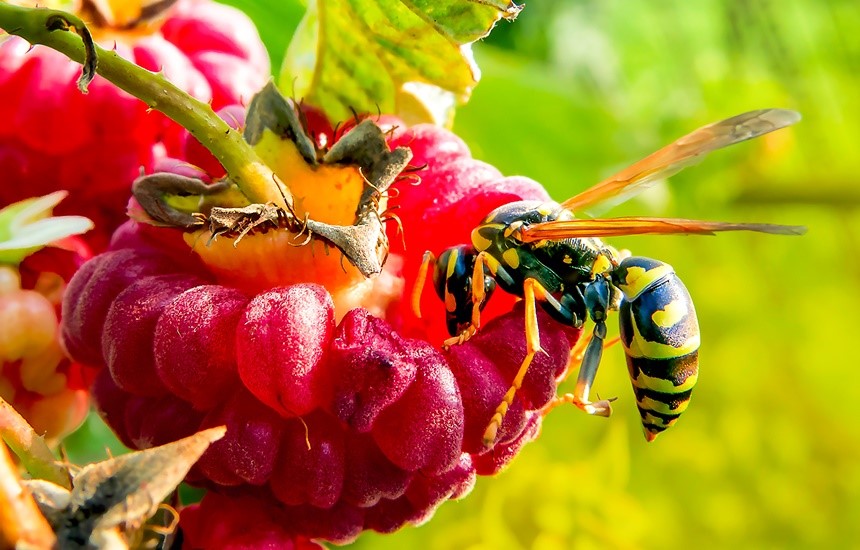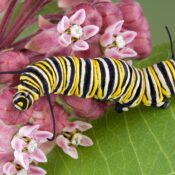In late spring and early summer, queen bees of various native species come out of hibernation to study the real-estate market for a nice place to raise a family. Strictly speaking, it’s only a “real” bee if it’s wearing fur, but not everyone wants to get close enough to see whether a bee-like thing is covered in enough hairs to meet the definition. If it looks and buzzes like a bee, it’s okay to call it one.

Except for those who are allergic to stings, most people feel rather warm and fuzzy toward honey bees, or at the very least, don’t hate them. After all, we all like honey.
Wasps, on the other hand, are often reviled and feared, not necessarily in that order. Wasps such as yellowjackets and bald-faced hornets only play nice with their own kind, and are otherwise distinctly antisocial. Ironically, they’re called social wasps because they live in colonies.

These socially challenged “social” wasps can be more dangerous than honey bees because they are known to vigorously defend their nests. And unlike honey bees, which die after stinging because their venom sacs tear away from their abdomens, wasps can sting repeatedly without paying with their lives. It makes you wonder if wasps are some sort of cosmic error in the same category as poison ivy, rats, and deer ticks. But wasps and hornets actually do a lot of good for our planet.
Solitary wasps, which by the way are much friendlier than social wasps, are generally bigger than other wasps. Because of their size, they can prey on larger insect pests such as locusts and emerald ash borers. Though each female wasp digs her own hole, a lot of these mini-nests can be concentrated in an area. You may have crossed a sandy lot and seen holes made by such creatures. If they were very active at the time, you might have been freaked out as they emerged en masse to see if you were the Uber Eats person delivering the bugs they ordered. These types of wasps rarely sting, except maybe if someone messes up their lunch order.
After paralyzing a bug with her sting, Ma Wasp carts it home, stuffs it down the nest-hole and injects eggs into it so her babies can hatch and eat their way out of the hapless victim. This is helpful in terms of controlling insect pests, but not very neighborly. One of the largest such critters in North America is called the cicada-killer wasp, a fearsome-looking assassin that is completely harmless. Unless you are a cicada.

At the other end of the size spectrum are braconid wasps. They’re often beautiful – metallic green or blue – and so tiny that they look like some kind of small fly. These wasps don’t have the horsepower to bring their victims home, so they lay eggs in fly larvae or pupae, and hope for the best. Braconids are among the most important pest-control insects on Earth.

What may come as a surprise is that even the scary wasps are essential pollinators. Not to take anything away from honey bees, but they’re just a small part of the pollinator picture. A 10-year Cornell study on bee diversity in New York State apple orchards revealed that, except in areas of extreme intensive agriculture, honey bee presence has no measurable effect on pollination rates. Bumble bees, mason bees, and other native bees, along with wasps and various non-bee insects, do the job quite nicely so long as they have access to wild, unkempt areas.
In our climate – I should say thus far at least –social wasp colonies do not overwinter (solitary wasps have a complex, Rube Goldberg-inspired system for getting through winter). In late summer, each colony will produce a few queens, along with a handful of disposable males with whom the queen will mate. Replete with fertilized eggs, queens will overwinter in leaf litter and rotten stumps, sometimes grouping together in eaves, attics, or other hibernacula. Every wasp we see at this time of year is a queen looking to found her own city-state, which may be disconcerting news to some. Take heart; they don’t all want to settle on your front porch.
In fact, wasp homes can take many shapes. Social wasps are expert paper-makers, chewing up wood and creating beautiful, if terrifying, nests. Paper wasps, which are tame by social-wasp standards, make open-faced “umbrella” homes, while hornets and yellowjackets make enclosed, globe-shaped nests. Hornets usually nest aloft, while yellowjackets also make underground homes.

Wasps do sometimes nest in problem locations such as schools, daycares, porches, and decks. Where children are at risk, call a professional right away. Large, populous nests at home may also require a pro. Always use a reliable source for advice on doing it yourself. Your local health department or Extension office will have bulletins on the safe removal of problem nests.
If you find a wasp nest anyplace other than right by your entry door, please leave it. They’re not “murder hornets,” so let’s stop murdering hornets, and let them bee.
Become a Saturday Evening Post member and enjoy unlimited access. Subscribe now



